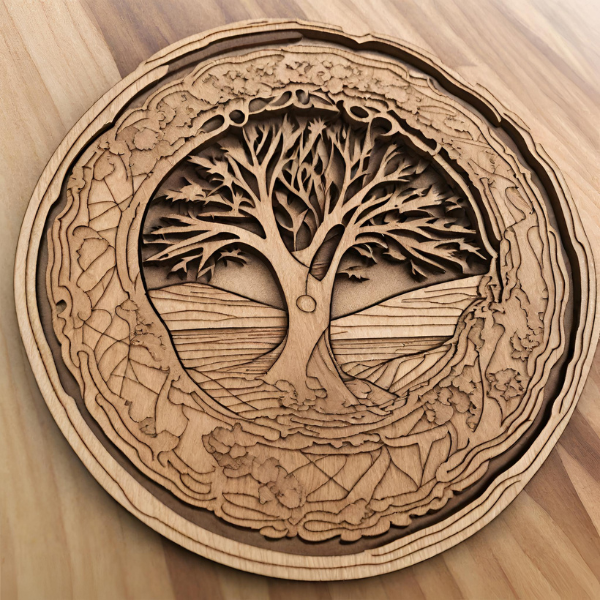Introduction to laser engraving technology
Basic principles of laser engraving on wood
Laser engraving on wood is a precise process. A laser beam is used to refine wooden surfaces. The material is removed by heat. This is how patterns, texts or images are created. The engraving depth and sharpness may vary. The result depends on the type of wood and laser settings. For best results you need to know both well.

Choosing the right laser engraver for wood projects
Choosing the right laser engraver is crucial to the success of your wood projects. Note these points:
- Performance: Choose a machine whose performance matches your project.
- Workspace: Pay attention to the size of the workspace for your projects.
- Material Compatibility: Make sure the laser engraver is suitable for different types of wood.
- Ease of use: A user-friendly device saves time and effort.
- Software: Good software is essential for precise designs.
- Support and Maintenance: Consider the customer service and maintenance options offered.
Pay attention to tests and reviews and compare prices. With the right selection, you can perfectly implement your creative ideas.
Safety considerations when laser engraving on wood
Safety is a must when working with laser engravers on wood. Here are important points for protection:
- Always wear safety glasses to protect your eyes from laser light.
- Provide good ventilation in the work area to remove fumes and smoke.
- Use only wood material suitable for laser engraving to avoid the risk of fire.
- Have a fire extinguisher ready in case ignition occurs.
- Learn about your laser engraver's emergency stop functions and how to use them.
These measures keep you and your work environment safe.
Innovative laser engravers for advanced users
The latest technological developments in laser engravers
Modern laser engravers offer advanced functions. They allow the finest engravings with high precision. The devices now work faster and more efficiently. Many models are equipped with more powerful lasers. You can also handle different types of wood. Integrated cameras ensure even more precise work. Some laser engravers have 3D engraving capabilities. Upgrades in software enable more complex designs. Users benefit from improved usability and support. All of this makes them ideal for woodworking professionals.
Adjustment options and special lasers for complex designs
Modern laser engravers are flexible. They allow devices to be optimized for difficult patterns. Such systems often have additional modules. For example, axial flatbed heads for fine work. Special lasers such as the CO2 laser are ideal for thick and hard wood. They can also be used to engrave deeper. Many machines now offer conversion kits. These kits make it easy to adapt to new wood types or styles. This means the laser engraver always remains state-of-the-art.
Software and digital design for precise engravings
Modern laser engravers for wood rely on sophisticated software. It ensures exact results. This software makes it possible to create complex designs digitally. Then the laser engraver engraves the design into the wood. It also offers editing and customization options. This allows you to refine motifs down to the last detail. Users can choose between different engraving styles. This allows engraving tailored to the project. The software also supports vector and raster graphics. This makes creative and versatile woodwork possible. This means that even beginners can quickly achieve good results. Advanced students use these programs to expand their skills.
Application examples and creative techniques
Showcase: Impressive projects with laser engraving on wood
Laser engraving on wood creates true works of art. This technique allows for the finest work. This also includes portrait motifs, delicate patterns and 3D effects. Many artists and craftsmen create unique pieces. For example, wooden signs for shops or weddings. Jewelry and pieces of furniture are also refined in this way. The precision of the laser is evident in every line. This creates high-quality and personal items made of wood.
Tips for beginners and professionals to refine the engraving technique
Mastering how to use a laser engraver for wood requires practice and knowledge. Here are some tips that can help both newbies and professionals refine their engraving technique:
- Material knowledge: Different types of wood react differently to laser beams. Get to know the properties of your wood to find the optimal engraving settings.
- Perform test runs: Perform small tests on scrap pieces to determine the best speeds and power settings.
- Focusing the laser: Precise focusing is crucial for sharp engravings. Check regularly whether the laser is set correctly.
- Use protective devices: Always ensure adequate protection against laser radiation and wood dust.
- Master software: In order to realize complex designs, it is essential to know the design software used well.
- Fine adjustment: Adjust speed and power gradually until the result meets your expectations.
- Maintenance of the device: Regular cleaning and maintenance increase the precision and service life of the laser engraver.
- Seek inspiration: View work from experts to discover new techniques and expand your own skills.
With these tips, you can gradually improve your laser engraving skills and achieve unique and sophisticated wood designs.
Future outlook: Sustainability and trends in wood finishing with laser technology
Sustainability is also becoming increasingly important in the area of wood finishing with laser technology. Future-oriented trends show that ecological aspects are increasingly coming into focus. Laser engravers that can be powered by renewable energy are a big topic. Using recycled wood for engraving projects is also gaining popularity. New software makes it possible to minimize material waste and increase the efficiency of lasers. Researchers are also developing laser engraving processes that do not require harmful chemicals. These developments suggest that wood finishing is not only becoming more creative and diverse, but also greener.










